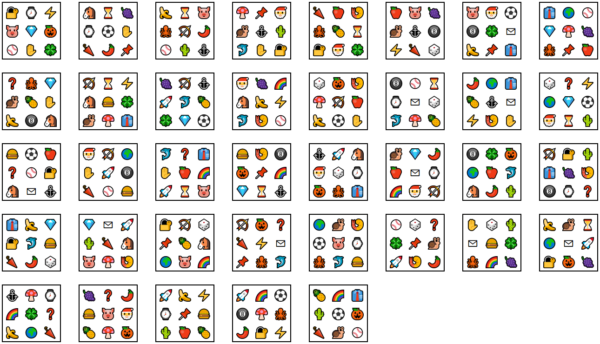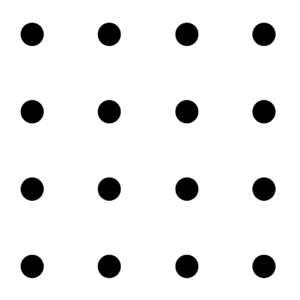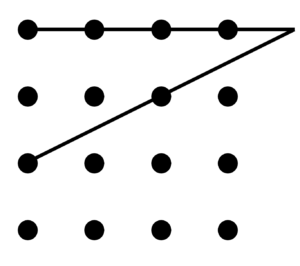Welcome to the twenty-second match in this year’s Big Math-Off. It’s back for one last gasp! Take a look at the two interesting bits of maths below, and vote for your favourite.
You can still submit pitches, and anyone can enter: instructions are in the announcement post.
Here are today’s two pitches.
Martin Harris – Double Dobble
Martin Harris tweets at @MarHarStar.
At a recent online maths meetup, we discussed the game Dobble. For those not familiar with the game, it consists of a deck of 55 cards (although it was shown that it could have been 57), each with eight symbols, and for any pair of cards, they will have exactly one symbol in common. Players must try to spot the common symbol the quickest to win the cards, and whoever has the most cards at the end of the game wins.
To demonstrate how constructing the deck works, imagine you have a deck of cards numbered 0 to 56 arranged in order in a circle. Let us define the interval between two cards as being the shortest distance between them around the circle. Then the interval between two cards numbered $a$ and $b (a \gt b)$ can be defined as:
another thing that prompted me to try this was this music theory video about “Everything Chords”, which is why it feels natural for me to use the term ‘interval’ here.
\[ \operatorname{interval}(a,b) = \min(a-b, 57-(a-b)) \]
As there are 57 cards in total, the maximum possible interval between two cards is $28 = \lfloor 57/2 \rfloor$. Each symbol is used on 8 cards, and therefore there are $28 = 8 \times 7 / 2$ intervals between them overall.
Now consider the subset of cards $\{0, 1, 3, 14, 32, 36, 43, 52\}$: here are the intervals between each pair of cards in that subset, with “$a-b$” intervals above the diagonal, and “$57-(a-b)$” intervals below.

Each possible interval is used exactly once!
If we place the same symbol on each of these cards, and then a different symbol on each card one higher than these numbers, and a third on each card two higher than these, and so on, we can build a full Dobble deck with 57 different symbols. Each card will have 8 symbols, and will share exactly one symbol with every other card.
So I got to thinking – can we use a method similar to this to find sets where each interval is used exactly twice? If so, we could make Double Dobble, where each pair of cards shares exactly two symbols.
There is also a very boring solution for 3 symbols per card which has 4 cards, 4 different symbols, and each card is missing one symbol. The fact that my code found this means that it’s working, but it’s not really worth showing here.
I wrote some Python code to look for solutions with different numbers of symbols on the cards, and I found solutions for 5 and 9 symbols per card. I then used the patterns I found to make some Double Dobble cards using emoji!
For 5 symbols per card, there are 11 different symbols in total, 11 cards in total, the interval diagram looks like this…

… and the deck I made looks like this:

For 9 symbols per card, there are 37 different symbols in total, 37 cards in total, the interval diagram looks like this…

… and the deck looks like this:

Why not try printing these out and playing Double Dobble? Enjoy!
Peter Rowlett – Moving on a strange diagonal
Peter Rowlett is a maths lecturer at Sheffield Hallam University. You can find him on Twitter at @peterrowlett.
A long time ago, I used to have a job visiting universities and talking to students about what they might do when they graduate and why they should join the IMA. At careers fairs, rather than leaflets, free pens and earnest chat about the future, I’d offer a kind of break-out activity for those who needed it, in the form of some puzzles.
Here is a puzzle I used to enjoy giving to students.
Given a 4×4 grid of sixteen dots, draw six straight lines that form a continuous path passing through all of the dots. Here, continuous means you must be able to draw over your six lines in one go without taking your pen off the paper.

This task is easy to complete with seven lines and impossible with five. Six is where the interesting puzzle lies.
I gave this to undergraduate students up and down the UK and I noticed a common response that makes me enjoy this puzzle and the lesson it teaches.
Many students would start playing with this puzzle, drawing lines on grids right away. This is good because playing is how you start to understand a puzzle and by showing their thought processes I could look out for when they have misunderstood the problem. The students who just stare at a blank page and are unable to make progress without externalising their struggle are frustratingly difficult to help. And, in my experience, this is a problem students would often misunderstand.
One approach I saw quite often was to draw lines within the grid always moving to the next adjacent dot – either up, down, left, right or diagonally. I would ask the student, why aren’t you drawing outside the grid? “What,” came the typical reply, “you’re allowed to go outside the grid?”
Then I would ask, why are you only moving to adjacent dots? Why not move at strange diagonals and jump around the grid in a more irregular fashion. Again, the response: “is that allowed?”
The statement of the problem was: “draw six straight lines that form a continuous path passing through all of the dots”. This says nothing to limit how you can move through the dots or where on the page you can draw your lines.

All the solutions I know involve a strange diagonal and leaving the confines of the grid. By imagining these additional conditions a student has created a new problem – one that cannot be solved.
Good puzzles lie on a thin line between easy and impossible, and the particular wording in the statement of the problem is likely to be very carefully chosen to give you enough to solve it without being too easy. A would-be puzzle solver must check the wording to be sure they are attempting the puzzle that has actually been set and not some imagined, impossible version.
Anyway, how many ways can you find the solve the puzzle?
So, which bit of maths made you say “Aha!” the loudest? Vote:
Match 22: Martin Harris vs Peter Rowlett
- Peter with a strange diagonal
- (53%, 23 Votes)
- Martin with double Dobble
- (47%, 20 Votes)
Total Voters: 43
This poll is closed.
The poll closes at 9am BST on the 26th, when the next match starts.
We’ve got no more pitches saved up, so this might be the last match this year, unless we get some more. If you’ve been inspired to share your own bit of maths, look at the announcement post for how to send it in. The Big Lock-Down Math-Off will keep running until we run out of pitches or we’re allowed outside again, whichever comes first.
There is a way to do it using only regular diagonals. If the bottom left dot is (0,0) and the lines go from there, the path is to (0,4), (4,0), (1,0), (4,3), (1,3), and finally to (1,1). This covers all points using only standard diagonals.